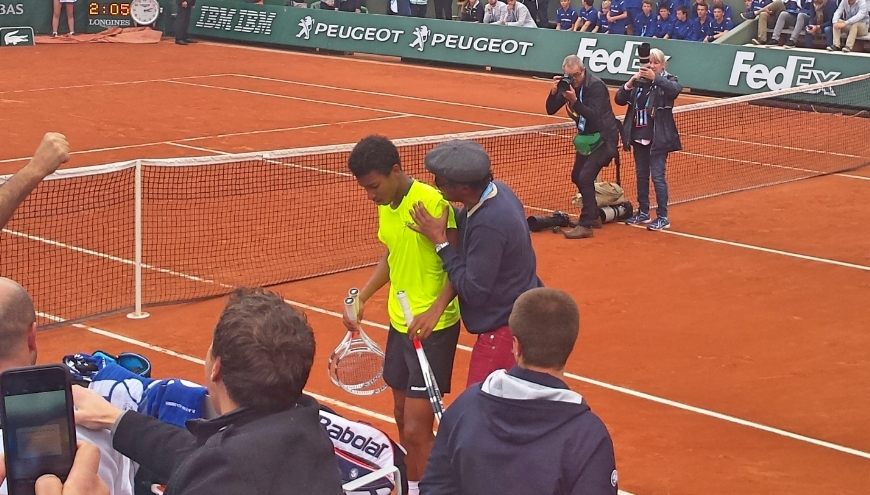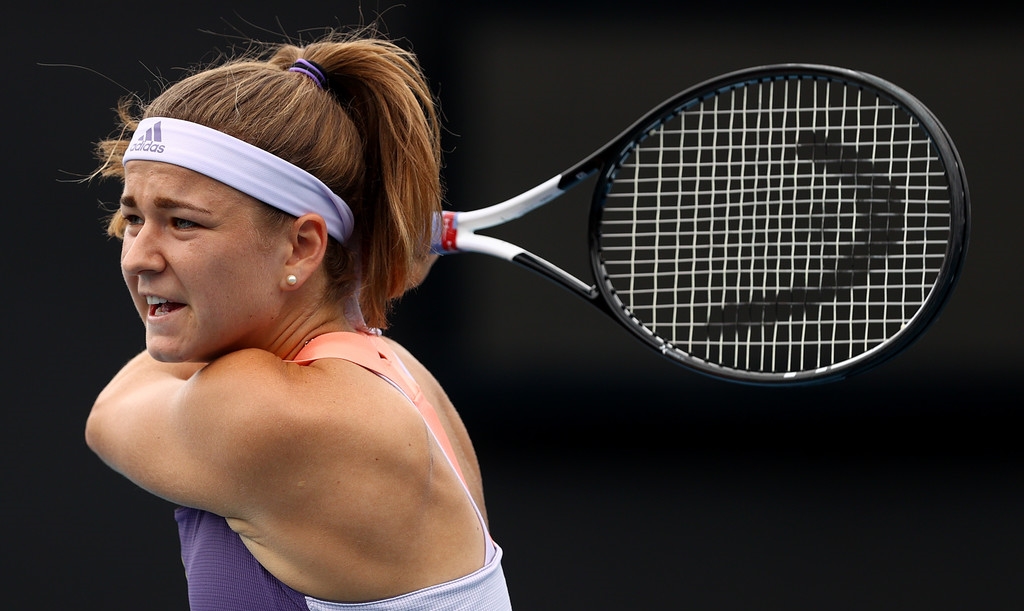Félix Auger-Aliassime (20) def. Denis Shapovalov (11) 7-5 7-5 6-3
Quality Plan A, recognition, poise!
I always underline the value of drawing up a good game plan before players step on the court, so I cannot help but wish I were a fly on the wall and listened in as Félix Auger-Aliassime and his team plotted the nuts and bolts of his strategy earlier on Friday over his upcoming match against his compatriot Denis Shapovalov.
Félix’s impeccable tactics led the way to earning him one of the most impressive wins of his career, a 7-5 7-5 6-3 victory over Denis, in a match that not only showcased his brilliant talent, but also his poise between the ears.
The first two sets were alike, with Denis going ahead by an early break, but Félix coming back to win each set 7-5. More than how the scoreline progressed, it’s rather the way in which Félix navigated the highs and lows at various points of the match and remained loyal to his working plan that proved top-notch. The latter consisted of sending the returns and the second shot in rallies deep, while avoiding taking unnecessary risks (read: not going for the lines, just deep to the middle of the court). The idea, I presume, was to establish early an equal footing in baseline rallies, goading his opponent into hitting riskier shots to end the point. Obviously, Denis was more likely to accelerate for the winner or at least control the point to squeeze an opportunity to come to the net rather than engage on long rallies. The longer the rallies went, the more time Denis spent behind the baseline, the better were the chances of Félix earning free points or get his own chance to finish the point.
To be fair, Shapovalov is a favorable match up, in my view, for Auger-Aliassime who has been frustrated in the past by players who count on consistency and keep a steady flow of deep balls coming back at him, thus not allowing Félix to dictate rallies (see this match report from 2020 Roland Garros for more on this). Shapovalov is not that type of player. He prefers to attempt winners from behind the baseline, make or miss, before most rallies reach 12 or 13 shots. I gather that Félix’s plan counted on him keeping the balls deep, not going for the lines too early, but still taking his chances when the opportunity presented itself (after all, it’s not like Félix is a “defensive” player either). It worked to perfection.
Auger-Aliassime seemed to recognize his opponent’s strengths and weaknesses, and that it was not going to be a perfect match from the first point to the last, even if he gets the lead in the scoreboard. Remaining focused on the task was the key to his success. Anyone who closely observed his body language throughout the match would probably agree that he passed the “focus” test with flying colors. He was tuned in, never showing exaggerated emotions, always keeping eyes on the ball, on his racket, or on the court.
The only bad patch for Félix took place early in the second set. With him leading 1-0, and 0-30 on Shapovalov’s serve, he had a chance to run away with the second set because Denis was just coming off a badly lost point at the end of which he went on a rant to his box and looked quite lost. Instead, Auger-Aliassime committed two unforced errors in a row to allow his opponent back into the game and reenter the match mentally. Denis took advantage with conviction, going on a positive stretch, lading a lot of returns in the court and putting some serious heat on his groundies to roll to a 4-2 lead (Félix’s two missed approach shots in the 2-2 game also played a role).
The reality is, as much as people constantly refer to both Shapovalov and Auger-Aliassime as “youngsters” and speak of their “growing pains,” these guys are, frankly, way beyond their ages in terms of maturity. They are not fragile youngsters like many other 20 and 21-year-olds. And in my view, they handle themselves well in the face of adversity during matches and know to evaluate matches with clarity. I would advise the casual tennis fan to listen to podcasts featuring either of these two “up-and-comers” or catch one of their post-match press conferences to witness for themselves the coherence of their thought process.
The above is a central part of the reason why, for example, Shapovalov knew to take advantage of Félix’s momentary blink at 0-1, 0-30 down, and it’s also why Auger-Aliassime did not fall apart after finding himself down 4-2 instead of running away with the set 15 minutes earlier. Auger-Aliassime’s body language looked no different at that point than it did earlier when he had the lead. Equally, watch Denis at 4-5 in the second set, how well he plays that game to stay in the set under pressure, shaking off the disappointment of losing the break minutes ago and finding himself in a position to hold, just to survive.
It was Auger-Aliassime finally ripping the 12th game away from Shapovalov to go up by two sets, rather than Denis giving it away. Félix, sticking to his plan, hit multiple returns back in the court deep, including in the last two points (his return on set point to the corner was exceptional, the more typical return he hit most of the match was in the point before at 30-30).
Auger-Aliassime’s gameplan reduced Shapovalov’s chances of winning points to mainly hitting great first serves or producing non-stop winners (read: taking more risks, even by his own standards). Needless to say, that is a big ask against a player as fast as Félix. Denis did not quit by any means but Félix, overflowing with confidence, was by then stroking freely and hardly making any errors. The way he protected the early break lead and shut the curtains on Shapovalov with four terrific serves served as an apt summary of the match.
The Canadian’s next-round opponent is Aslan Karatsev. It’s another opponent against whom Auger-Aliassime will not have to resort to long rallies, so a similar game plan may possibly work again. Except… have you watched Karatsev?** He can nail winners from anywhere on the court but don’t take my word for it. Watch the replay of his matches this week, especially how helpless he made Schwartzman look at times even though the Argentine is one of the better baseliners in the game.
** Popular question, it seems, all of a sudden.

Karolina Muchova (25) def. Karolina Muchova (6) 7-5 7-5
Scoreboard and self-awareness!
Considering their last thriller at Wimbledon in 2019 (13-11 in the final set), this match between two friends who know each other’s game like the back of their hands promised much intrigue. In the first set, neither player put out high-quality performances (Muchova admitted after the match that she came out nervous and thought that maybe her opponent did too). It was a patchy set, with good and bad moments. The difference was on serves, with Muchova giving a clinic on clutch first serves in the latter part of the set, starting with the break point save at 3-4, 30-40. Pliskova, for her part, was not getting the free points from her serves like she usually does and sputtered five double faults, the last one coming on break point down at 5-5.
Pliskova was frustrated and took it out on her rackets, smashing one in the 5-6 game, and another one in the tunnel when she took a break before the start of the second set. That put her down 0-15 to start the second set on a point penalty. Note: I admit, I had no idea that you could be penalized for racket abuse in the tunnel, away from the court. The official who accompanied her reported the infraction to the chair umpire who announced it and slapped the point penalty. Pliskova thought she could “do what [I] want off court.” Apparently not!
Perhaps, that helped her shake the negative vibes out, because she came out smashing her baseline shots, and more importantly, suddenly reading Muchova’s serves like an open book. At one point, Muchova’s points won on second serves dipped to the 20% range and she was not faring much better on her first serves. Pliskova, on a roll, overpowered her way to a 5-0 lead.
Lesson time here…With Karolina Muchova as your instructor…
Muchova came out of the 0-5 break sprinting to the baseline for the first point, as if she were getting ready to play a decisive tiebreaker. After she won the first point, she made a big fist pump, acting as if she got the mini-break lead in that tiebreaker. Why so pumped up out of nowhere at 0-5 down? I am fairly certain that it was not necessarily because she firmly believed, at that point, in her chances to come back from 0-5 down and win the set.
It was rather because she understood the importance of starting the third set with her serve, thus the urgency to hold for 1-5. And if she happened to win the next game to get one break back, that much better. It would mean that she clawed her way back into the match game-wise – and mentally – and be primed for the third, even if she were to lose the second set.
Well, she did indeed get the break and hold for 3-5, and more. So, in retrospect, what may have appeared an exaggerated display of emotional positivity considering the 0-5 score not only served its purpose – halting Pliskova’s roll on the scoreboard and dominance in rally patterns –, but also led to perhaps the most riveting comeback in a set in this tournament so far.
By the time Muchova got in position to level the set at 5-5 on her serve, she was dialed in, pulling off stellar shots on big points. Case in point number one, Pliskova had a last glimmer of hope to close the set out at 4-5, 30-40 on Muchova’s serve, and Muchova erased it with high-velocity first serve to the “T.” Case in point number two at 5-5, with Pliskova serving at 40-30, Muchova showed her underrated footwork to reach Pliskova’s drop shot and placed a sharp-angled placement shot on the full run (this is harder to do than she made it look, easier to rip one on the full run than “caressing” the ball to place it).
Muchova broke her opponent’s serve and held to end the match. The last two games were contested and while Muchova missed a couple of makeable approach shots, she more than made up for it with her anticipation on returns, winner production, and overall aggressive play (propelled by confidence originating in that 0-5 game). The rally patterns late in the set were the reverse of those seen in the first five games with Muchova being the aggressor this time.
She will next face the winner of the match between Belinda Bencic and Elise Mertens.
Note: For those interested, you can also find my match report on Muchova’s previous-round win over Mona Berthel by clicking here.


Wonderful analysis from both a tennis and human perspective
Thank you Brendan!
Much appreciated feedback.